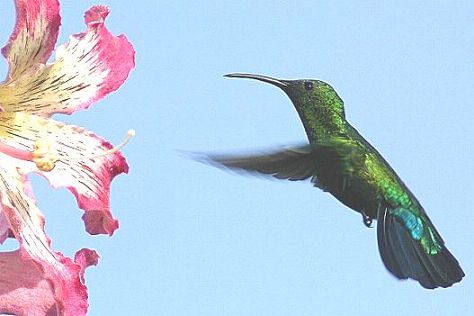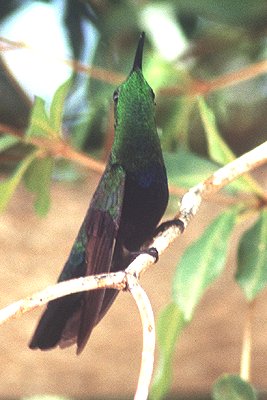|
Green-throated Carib Eulampis holosericeus Zumbador de Pecho Azul,
|
 |
|
Photo: R. & E. Tyrrell*
|
|
Green-throated Carib Eulampis holosericeus Zumbador de Pecho Azul,
|
 |
|
Photo: R. & E. Tyrrell*
|
|
IDENTIFICATION: A large hummingbird with a downward curved bill. Both sexes have similar plumage---green above, with a black belly and a brilliant, iridescent green throat and breast. The lower border of the breast has a thin blue line, visible in the right light angle. The female’s bill is somewhat longer and more curved than the male’s. Length: 10-12 cm.; weight: 4.9-7.8 g. VOICE: The call is described as a harsh "chewp." HABITAT: Forests, mangroves, and gardens. HABITS: Feeds on insects (flies, small wasps, lantern flies, leafhoppers, beetles), spiders and some nectar. It is readily attracted to sugar water feeders, which it defends against other hummingbirds and Bananaquits. It sometimes catches insects in the air. This species typically breeds from March to July but can nest at other times. The female builds a well-hidden nest in a dense shrub or low in a tree. The nest is constructed of bark, lichens, and leaves, with a soft interior lining of downy plant fibers and feathers. The female lays two white eggs and does all the incubation and caring for the nestlings. STATUS AND CONSERVATION: Common, but local, resident of Puerto Rico. The Green-throated Carib starred on a 32-cent U.S. postage stamp (1998 Tropical Bird stamp series # 445915). RANGE: Has been reported from much of lowland Puerto Rico, but typically breeds in eastern Puerto Rico, Culebra, and Vieques, east to Barbados. This is the common large hummingbird on Culebra and Vieques. Recently this species has been found near the entrance to the Parque Lineal in San Juan’s Parque Central, and on the grounds of eastern hotels such as the Crows Nest on Vieques and Club Seaborne on Culebra. TAXONOMY: TROCHILIDAE; Trochilinae |
 |
|
Photo: A. Sánchez Muñoz
|
 |
|
Photo: J. Faaborg*
|
 |
|
Photo: G. Dremeaux
|
|
References Chavez-Rámirez, F. and S. S. Tan. 1993. Habitat separation and arthropod resource use in three Lesser Antillean hummingbirds. Condor 95:455-458. del Hoyo, J., A. Elliott, and J. Sargatal, eds. 1999. Handbook of the Birds of the World, Vol. 5. Barn Owls to Hummingbirds. Lynx Edicions, Barcelona. Gerwin, J. A., and R. M. Zink. 1998. Phylogenetic patterns in the Trochilidae. Auk 115: 05-118. Kodric-Brown, A., J.H. Brown, G.S. Byers, and D.F. Gori. 1984. Organization of a tropical island community of hummingbirds and flowers. Ecology 65:1358-1368. Raffaele, H.A. 1989. A guide to the birds of Puerto Rico and the Virgin Islands. Princeton. Raffaele, H.A. 1989. Una guía a las aves de Puerto Rico y las Islas Vírgenes. Publishing Resources, Inc., Santurce, PR. Raffaele, H.A., J.W. Wiley, O.H. Garrido, A.R. Keith, and J.I. Raffaele. 1998. Guide to the birds of the West Indies. Princeton. Sorrie, B.A. 1975. Observations on the birds of Vieques Island, Puerto Rico. Carib. J. Sci. 15:89-103. Tyrrell, E.Q. and R.A.Tyrrell. 1990. Hummingbirds of the Caribbean. Crown Publishers, NY. Wetmore, A. 1916. Birds of Porto Rico. U.S. Dept. of Agriculture Bull. No. 326. Green-throated Carib, Spanish text Next related species in taxonomic order Previous related species in taxonomic order |